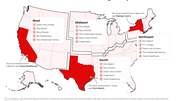Operations
5 ways to secure a fair deal with third-party companies
Online ordering is growing and here to stay, with two-thirds of restaurants now receiving 20% or more of their revenue from marketplaces, according to Technomic, which means fast casual brands must stake out a profitable long-term digital strategy that includes — like it or not building — third-party relationships.

August 3, 2020 by Kevin Ziegler — Principal, kaz strategy
Online ordering is growing and here to stay, with two-thirds of restaurants now receiving 20% or more of their revenue from marketplaces, according to Technomic, which means fast casual brands must stake out a profitable long-term digital strategy that includes — like it or not building — third-party relationships.
This is only made more challenging for restaurants as marketplaces consolidate — with a merged Uber and Postmates having an estimated 37% U.S. market share — for example. With a thorough strategy, however, gains can still be made.
Before engaging marketplaces in negotiation, here are tips for preparing an assertive strategy.
- Know your profits, not just revenue from marketplace business
Negotiation preparation starts with analyzing company trends across ordering channels, offline and online, at the unit level. Understanding the share of overall profits, not just revenue, that are coming from online ordering channels, including marketplaces, helps assess points of strength and weakness.
A marketplace that generates significant revenue, but minimal profits, can suggest varying strategic options, from setting a fee reduction goal, to walking away from an unprofitable channel. Having this data-driven view is also crucial for franchised chains, as franchise partners will expect a credible plan to improve profitability, especially if it involves forgoing any revenue streams. - Assess your own direct ordering channels
An unmistakable key to reducing reliance on third-party marketplaces is offering a comparable online ordering experience for customers on your own channels. For those that have invested in brand-owned ordering sites and apps, a self-assessment of the ordering experience compared to marketplaces may uncover opportunities for improvement that should be addressed in parallel to a marketplace strategy.
Online ordering platforms involve fees as well, but generally speaking, the breakeven point is low, with leading platforms costing around $100 per month per unit. The good news is, multiple studies confirm that customers prefer to order from restaurants' sites rather than through delivery apps, by as much as a 2:1 margin.
The assessment can start simply, and outcomes can range from simplifying menu options to exploring alternative online ordering platforms with desired features. - Gauge your ability to shift customers to lower-cost ordering channels
Negotiating strength in part comes from the ability and wherewithal to recapture customers from a marketplace or to attract and retain new ones, which is the aim of loyalty and CRM programs.
This is also the place to assess marketing and promotion budgets. Franchise-driven chains will need to maintain buy-in from this stakeholder group before enacting any plans.
A strong walk away position includes the willingness and a credible plan to replace revenue from the channel in focus. The plan must include realistic forecasts for the recapture period that are likely to secure stakeholder buy-in for a tough bargaining approach.
The plan also need not be deployed only during a negotiation, as loyal customers are known to be more valuable, and can replace many more indirect customers coming through marketplaces.
Alternatively, a cost-reduction strategy can also include efforts to shift business from one marketplace to a lower-cost one. - Know what marketplaces want and go beyond fees
Marketplaces have been clear that growing supply is among their top priorities. It's also led to initiatives like GrubHub's unpopular of taking orders and making deliveries for restaurants where they do not have an agreement in place.
Because of this, chains with more saturation in a specific geographic market can still exercise negotiation strength typically afforded to the largest chains, as marketplaces do not want to lose any supply or market share. Even smaller brands with signature menu items that can attract new customers to a marketplace have additional bargaining power.
There are other profit-influencing considerations beyond core fees to consider that can also provide options to avoid a stalled negotiation. Strongly positioned brands can seek customized deals that address other common relationship pain points such as differentiated pricing across channels, search keyword bidding restrictions and responsibility for driver errors. - Prepare a walk-away plan
The last part of preparation goes beyond the assessment, it's having a mitigation plan ready. Before entering a negotiation, pairing the financial implications of parting ways with a "shovel-ready" marketing and operations plan ensures your negotiation team will have the stamina to reach the best terms or to secure the attention of large marketplace partners.
This activity is as much about strategy as it is about planning and operations. It requires an all-hands on deck approach with real budgets and plans in place should they be needed. It also requires thorough communications preparation to ensure that key parties are kept informed throughout the negotiation. this includes investors, executives and franchisees and in some cases, can include readiness for news media engagement.












